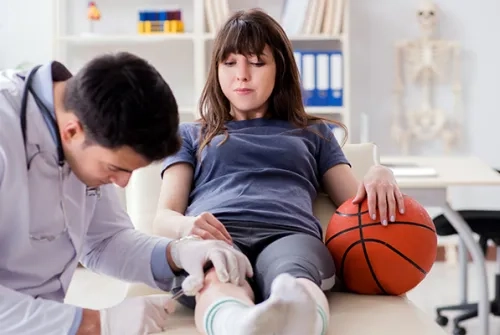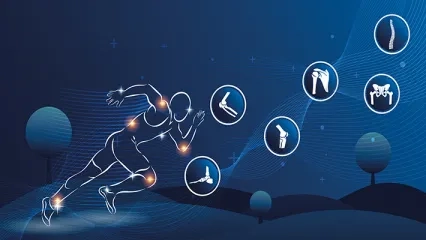Alo Yeditepe
Alo Yeditepe
Higher Risk of Anterior Cruciate Ligament and Ankle Injury in Female Athletes
Higher Risk of Anterior Cruciate Ligament and Ankle Injury in Female Athletes
Orthopedics and Traumatology specialist Prof. Dr. Hasan Bombacı said that epidemiological studies have shown that female athletes have a higher risk of sports injuries, especially in the lower extremity musculoskeletal system, than male athletes. Statistics on the gender gap in sports injuries show that the injury rate of female athletes compared to male athletes is generally close to each other when common sports branches are taken into account. However, especially among knee injuries, anterior cruciate ligament injuries are more common in women, while injuries in different regions such as shoulders and hips are more common in men, Orthopedics and Traumatology specialist Prof. Bombacı said, “Sports injuries are an important problem that concerns everyone of all ages, regardless of gender. In order to ensure the continuity of sports life, it is necessary to be conscious and cautious both in the prevention of injuries and in the treatment and afterwards.
"The most important factor is anatomical and biological differences."
Emphasizing the differences between male and female sports injuries, Yeditepe University Koşuyolu Hospital Orthopedics and Traumatology specialist Prof. Dr. Hasan Bombacı stated that female athletes have a higher risk of knee and ankle ligament injuries, especially in the lower extremity musculoskeletal system, and continued as follows:
“This result is due to some gender-specific anatomical and biological differences between men and women. In women's monthly periods, depending on the concentration of hormones in the body, there may be loosening in the ligaments, softening, and decrease in the resistance of the tendons. Therefore, women are more prone to injury, especially during some periods of the menstrual cycle.”
“The ligaments most prone to injury are in the knees.”
Although all ligaments are generally affected by the hormonal change in women, Prof. Dr. Hasan Bombacı said,
“Especially in competitive sports, when performing actions such as stopping and turning abruptly in the situation required by mutual struggle, much more load is placed on the joints and muscles. If there is loosening in the ligaments unlike normal, this reduces the joint-retaining effect of the ligaments. Against this abnormal load that comes naturally, the possibility of damage to the joints and ligaments increases. said.
Anatomical Differences Also Increase Risk in Women
Explaining that women are anatomically different from men apart from hormones, another factor that increases the risk is Prof. Dr. Hasan Bombacı explained the following on the subject:
“For example, women's legs are turned outward a little more than men's. This situation, which is related to the biology of women, is defined as “valgus angulation”. The valgus angulation in the knee causes the knee to become unbalanced earlier in the face of abnormal stresses, especially in sudden turns and sudden stops. And this increases the probability of damage to the load on that area. For example, when an athlete running in handball approaches the goal, he or she applies a more than normal rotational force to the knee as he jumps up and lands on his leg to shoot. If the athlete has not gained the reflexes to create the necessary activity for these situations, the probability of encountering ligament injury will be high. Apart from this, it is claimed that the anterior cruciate ligament in women is thinner than men due to their anatomy, which is responsible for this situation.
Amateur Athletes Should Also Pay Attention!
Stating that injuries are an important problem not only among professional athletes, but also among amateur athletes, Prof. Bombacı emphasized the importance of taking precautions and being conscious while doing sports. However, he stated that amateur athletes are not usually involved in competitive sports and therefore the risk of injury is lower.
If Adequate Precautions are not Taken, the Probability of Recurrence is High
Underlining that in such sports injuries, very effective results can be obtained with treatment and it is possible to return to sports, Prof. Dr. Bomber underlined that necessary precautions should be taken only during and after the treatment. prof. Bomber continued:
“Treatment can restore a person to the state they were in before the accident happened at most. For example, as a result of the most common anterior cruciate ligament injury, 70-80 percent of athletes can return to sports and their previous performance level. However, re-injury is inevitable if an exercise program is not undertaken to neutralize this disadvantage. Moreover, in this case, the risk increases even more with the weakness created by the previous injury.”
What should be done to be protected?
Prof. Dr. Hasan Bombacı stated that this gap can be covered to a large extent with appropriate training techniques and, more importantly, special "proprioception exercises", and said, "Special exercise programs are very effective in reducing the risk, but it is important to know the techniques related to sports as well.
According to the analysis of the injury mechanism of the athlete, there are scientific data showing that “exercise-based” rehabilitation, as well as training in many aspects such as endurance, agility, balance and strengthening, reduce these injuries by 27-45 percent. Potential sports injury risks related to anatomy and biology of female athletes can be significantly reduced by exercise programs that increase their neuromotor abilities. As a result, it has been scientifically proven that the risk of injury in some body parts of female athletes is higher than that of male athletes. However, it is very important to take appropriate precautions while doing sports and to work with preparatory training techniques specific to the sport. In this way, it may be possible to prevent sports injuries and to manage the treatment process more effectively.” used the phrases.
Press Coverage: cnnturk | posta | cumhuriyet | sabah | yenicaggazetesi | halktv
About
Faculty and Year of Graduation:
İstanbul Faculty of Medicine, 1986
”
See Also
- What are Hip Joint Diseases? Causes and Treatment
- Robotic Hip Replacement Surgery
- What is Hallux Rigidus (Stiff Big Toe/Toe Arthritis)? Symptoms and Treatment
- What is Hallux Valgus (Bunion)? How is it Treated?
- Ergonomics in Automobiles Prevents Accidents
- Walking and Returning to Social Life After Knee Replacement Surgery
- What Are the Advantages of Robotic Knee Replacement Surgery?
- Robotic Knee Prosthesis Surgery
- The Usage Area of Robotic Surgery Expands in Orthopedic Surgeries
- Spinal Fractures
- Big Toes Can Be A Big Problem!
- Hip Osteoarthritis and Hip Prosthesis
- Not Only Athletes Suffer from Meniscus Tears!
- Mistakes While Swimming Can Cause Shoulder Pain
- Myths About Fractures
- The First Onset of Pain in Cartilage Damage in the Knee Should Not Be Overlooked
- Sports Injuries
- 8 Common Misconceptions About Sports Injuries
- Knee Arthritis
- Knee Pain
- Treatment of Knee Arthrosis Varies According to the Person
- A Lack of Attention to Sports Injuries in Children May Affect Their Development
Alo Yeditepe




